A Review: Halogenated Compounds from Marine Actinomycetes
Abstract
1. Introduction
2. Halogenated Compounds from Streptomyces Species
2.1. Sponges-Associated Streptomyces sp.
2.2. Corals-Associated Streptomyces sp.
2.3. Streptomyces sp. from Other Marine Animals
2.4. Streptomyces sp. from Marine Sediments
2.5. Streptomyces sp. from Other Marine Sources
3. Halogenated Compounds from Other Marine Actinomycetes
3.1. Other Marine Sediments-Associated Actinomycetes
3.2. Other Ascidian-Associated Actinomycetes
3.3. Other Marine Source-Associated Actinomycetes
4. Summary
Author Contributions
Funding
Institutional Review Board Statement
Informed Consent Statement
Data Availability Statement
Acknowledgments
Conflicts of Interest
References
- Zhao, C.; Zhu, T.; Zhu, W. New marine natural products of microbial origin from 2010 to 2013. Chin. J. Org. Chem. 2013, 33, 1195–1234. [Google Scholar] [CrossRef]
- Wang, C.; Mei, X.G.; Zhu, W.M. New natural products from the marine-derived Streptomyces actinobacteria. Stud. Mar. Sin. 2016, 51, 86–124. [Google Scholar]
- Kasanah, N.; Triyanto, T. Bioactivities of halometabolites from marine actinobacteria. Biomolecules 2019, 9, 225. [Google Scholar] [CrossRef] [PubMed]
- Motohashi, K.; Takagi, M.; Shin-Ya, K. Tetrapeptides possessing a unique skeleton, JBIR-34 and JBIR-35, isolated from a sponge-derived actinomycete, Streptomyces sp. Sp080513GE-23. J. Nat. Prod. 2010, 73, 226–228. [Google Scholar] [CrossRef]
- Muliandi, A.; Katsuyama, Y.; Sone, K.; Izumikawa, M.; Moriya, T.; Hashimoto, J.; Kozone, I.; Takagi, M.; Shin-ya, K.; Ohnishi, Y. Biosynthesis of the 4-methyloxazoline-containing nonribosomal peptides, JBIR-34 and-35, in Streptomyces sp. Sp080513GE-23. Chem. Biol. 2014, 21, 923–934. [Google Scholar] [CrossRef]
- Jakubiec-Krzesniak, K.; Rajnisz-Mateusiak, A.; Guspiel, A.; Ziemska, J.; Solecka, J. Secondary metabolites of actinomycetes and their antibacterial, antifungal and antiviral properties. Pol. J. Microbiol. 2018, 67, 259. [Google Scholar] [CrossRef]
- Cheng, C.; Othman, E.M.; Reimer, A.; Grüne, M.; Kozjak-Pavlovic, V.; Stopper, H.; Hentschel, U.; Abdelmohsen, U.R. Ageloline A, new antioxidant and antichlamydial quinolone from the marine sponge-derived bacterium Streptomyces sp. SBT345. Tetrahedron Lett. 2016, 57, 2786–2789. [Google Scholar] [CrossRef]
- Shaala, L.A.; Youssef, D.T.; Alzughaibi, T.A.; Elhady, S.S. Antimicrobial chlorinated 3–phenylpropanoic acid derivatives from the Red Sea marine actinomycete Streptomyces coelicolor LY001. Mar. Drugs 2020, 18, 450. [Google Scholar] [CrossRef]
- Fu, P.; Kong, F.; Wang, Y.; Wang, Y.; Liu, P.; Zuo, G.; Zhu, W. Antibiotic metabolites from the coral–associated actinomycete Streptomyces sp. OUCMDZ–1703. Chin. J. Chem. 2013, 31, 100–104. [Google Scholar] [CrossRef]
- Trischman, J.A.; Tapiolas, D.M.; Jensen, P.R.; Dwight, R.; Fenical, W.; McKee, T.C.; Ireland, C.M.; Stout, T.J.; Clardy, J. Salinamides A and B anti-inflammatory depsipeptides from a marine Streptomycete. J. Am. Chem. Soc. 1994, 116, 757–758. [Google Scholar] [CrossRef]
- Lin, Z.; Flores, M.; Forteza, I.; Henriksen, N.M.; Concepcion, G.P.; Rosenberg, G.; Haygood, M.G.; Olivera, B.M.; Light, A.R.; Cheatham, T.E., III; et al. Totopotensamides, polyketide–cyclic peptide hybrids from a mollusk-associated bacterium Streptomyces sp. J. Nat. Prod. 2012, 75, 644–649. [Google Scholar] [CrossRef]
- Lacret, R.; Pérez-Victoria, I.; Oves-Costales, D.; De la Cruz, M.; Domingo, E.; Martín, J.; Díaz, C.; Vicente, F.; Genilloud, O.; Reyes, F. MDN-0170, a new napyradiomycin from Streptomyces sp. strain CA-271078. Mar. Drugs 2016, 14, 188. [Google Scholar] [CrossRef]
- Carretero-Molina, D.; Ortiz-López, F.J.; Martín, J.; Oves-Costales, D.; Díaz, C.; de la Cruz, M.; Cautain, B.; Vicente, F.; Genilloud, O.; Reyes, F. New napyradiomycin analogues from Streptomyces sp. strain CA-271078. Mar. Drugs 2020, 18, 22. [Google Scholar] [CrossRef]
- Li, F.; Maskey, R.P.; Qin, S.; Sattler, I.; Fiebig, H.H.; Maier, A.; Zeeck, A.; Laatsch, H. Chinikomycins A and B: Isolation, structure elucidation, and biological activity of novel antibiotics from a marine Streptomyces sp. isolate M045#. J. Nat. Prod. 2005, 68, 349–353. [Google Scholar]
- Cho, J.Y.; Kwon, H.C.; Williams, P.G.; Jensen, P.R.; Fenical, W. Azamerone, a terpenoid phthalazinone from a marine-derived bacterium related to the genus Streptomyces (Actinomycetales). Org. Lett. 2006, 8, 2471–2474. [Google Scholar] [CrossRef] [PubMed]
- Schnell, S.D.; Linden, A.; Gademann, K. Synthesis of two key fragments of the complex polyhalogenated marine meroterpenoid azamerone. Org. Lett. 2019, 21, 1144–1147. [Google Scholar] [CrossRef]
- Bugni, T.S.; Woolery, M.; Kauffman, C.A.; Jensen, P.R.; Fenical, W. Bohemamines from a marine-derived Streptomyces sp. J. Nat. Prod. 2006, 69, 1626–1628. [Google Scholar] [CrossRef] [PubMed]
- Martin, G.D.; Tan, L.T.; Jensen, P.R.; Dimayuga, R.E.; Fairchild, C.R.; Raventos-Suarez, C.; Fenical, W. Marmycins A and B, cytotoxic pentacyclic C-glycosides from a marine sediment-derived actinomycete related to the genus Streptomyces. J. Nat. Prod. 2007, 70, 1406–1409. [Google Scholar] [CrossRef] [PubMed]
- Shin, H.J.; Jeong, H.S.; Lee, H.S.; Park, S.K.; Kim, H.M.; Kwon, H.J. Isolation and structure determination of streptochlorin, an antiproliferative agent from a marine-derived Streptomyces sp. 04DH110. J. Microbiol. Biotechnol. 2007, 17, 1403–1406. [Google Scholar]
- Jia, C.Y.; Xu, L.Y.; Yu, X.; Ding, Y.B.; Jin, B.; Zhang, M.Z.; Zhang, W.H.; Yang, G.F. An efficient synthesis and antifungal evaluation of natural product streptochlorin and its analogues. Fitoterapia 2018, 125, 106–110. [Google Scholar] [CrossRef] [PubMed]
- Miller, E.D.; Kauffman, C.A.; Jensen, P.R.; Fenical, W. Piperazimycins: Cytotoxic hexadepsipeptides from a marine–derived bacterium of the genus Streptomyces. J. Org. Chem. 2007, 72, 323–330. [Google Scholar] [CrossRef]
- Li, W.; Gan, J.; Ma, D. Total synthesis of piperazimycin A: A cytotoxic cyclic hexadepsipeptide. Angew. Chem. Int. Ed. 2009, 121, 9053–9057. [Google Scholar] [CrossRef]
- Soria–Mercado, I.E.; Prieto–Davo, A.; Jensen, P.R.; Fenical, W. Antibiotic terpenoid chloro–dihydroquinones from a new marine actinomycete. J. Nat. Prod. 2005, 68, 904–910. [Google Scholar] [CrossRef] [PubMed]
- Winter, J.M.; Moffitt, M.C.; Zazopoulos, E.; McAlpine, J.B.; Dorrestein, P.C.; Moore, B.S. Molecular basis for chloronium–mediated meroterpene cyclization-cloning, sequencing, and heterologous expression of the napyradiomycin biosynthetic gene cluster. J. Biol. Chem. 2007, 282, 16362–16368. [Google Scholar] [CrossRef] [PubMed]
- Farnaes, L.; Coufal, N.G.; Kauffman, C.A.; Rheingold, A.L.; DiPasquale, A.G.; Jensen, P.R.; Fenical, W. Napyradiomycin derivatives, produced by a marine–derived actinomycete, illustrate cytotoxicity by induction of apoptosis. J. Nat. Prod. 2014, 77, 15–21. [Google Scholar] [CrossRef]
- Hughes, C.C.; Prieto-Davo, A.; Jensen, P.R.; Fenical, W. The marinopyrroles, antibiotics of an unprecedented structure class from a marine Streptomyces sp. Org. Lett. 2008, 10, 629–631. [Google Scholar] [CrossRef] [PubMed]
- Hughes, C.C.; Kauffman, C.A.; Jensen, P.R.; Fenical, W. Structures, reactivities, and antibiotic properties of the marinopyrroles A–F. J. Org. Chem. 2010, 75, 3240–3250. [Google Scholar] [CrossRef]
- Hughes, C.C.; MacMillan, J.B.; Gaudêncio, S.P.; Jensen, P.R.; Fenical, W. The ammosamides: Structures of cell cycle modulators from a marine–derived Streptomyces species. Angew. Chem. Int. Ed. Engl. 2009, 48, 725–727. [Google Scholar] [CrossRef]
- Hughes, C.C.; Fenical, W. Total synthesis of the ammosamides. J. Am. Chem. Soc. 2010, 132, 2528–2529. [Google Scholar] [CrossRef] [PubMed]
- Hawas, U.W.; Shaaban, M.; Shaaban, K.A.; Speitling, M.; Maier, A.; Kelter, G.; Fiebig, H.H.; Meiners, M.; Helmke, E.; Laatsch, H. Mansouramycins A–D, cytotoxic isoquinolinequinones from a marine Streptomycete. J. Nat. Prod. 2009, 72, 2120–2124. [Google Scholar] [CrossRef]
- Coppola, A.; Sucunza, D.; Burgos, C.; Vaquero, J.J. Isoquinoline synthesis by heterocyclization of tosylmethyl isocyanide derivatives: Total synthesis of mansouramycin B. Org. Lett. 2015, 17, 78–81. [Google Scholar] [CrossRef] [PubMed]
- Kwon, H.C.; Espindola, A.P.D.; Park, J.S.; Prieto-Davó, A.; Rose, M.; Jensen, P.R.; Fenical, W. Nitropyrrolins A–E, cytotoxic farnesyl–α–nitropyrroles from a marine–derived bacterium within the actinomycete family Streptomycetaceae. J. Nat. Prod. 2010, 73, 2047–2052. [Google Scholar] [CrossRef] [PubMed]
- Kaysser, L.; Bernhardt, P.; Nam, S.J.; Loesgen, S.; Ruby, J.G.; Skewes-Cox, P.; Jensen, P.R.; Fenical, W.; Moore, B.S. Merochlorins A–D, cyclic meroterpenoid antibiotics biosynthesized in divergent pathways with vanadium–dependent chloroperoxidases. J. Am. Chem. Soc. 2012, 134, 11988–11991. [Google Scholar] [CrossRef]
- Zhang, W.; Liu, Z.; Li, S.; Yang, T.; Zhang, Q.; Ma, L.; Tian, X.; Zhang, H.; Huang, C.; Zhang, S.; et al. Spiroindimicins A–D: New bisindole alkaloids from a deep–sea–derived actinomycete. Org. Lett. 2012, 14, 3364–3367. [Google Scholar] [CrossRef] [PubMed]
- Zhang, W.; Ma, L.; Li, S.; Liu, Z.; Chen, Y.; Zhang, H.; Zhang, G.; Zhang, Q.; Tian, X.; Yuan, C.; et al. Indimicins A–E, bisindole alkaloids from the deep–sea–derived Streptomyces sp. SCSIO 03032. J. Nat. Prod. 2014, 77, 1887–1892. [Google Scholar] [CrossRef]
- Teufel, R.; Kaysser, L.; Villaume, M.T.; Diethelm, S.; Carbullido, M.K.; Baran, P.S.; Moore, B.S. One-pot enzymatic synthesis of merochlorin A and B. Angew. Chem. Int. Ed. 2014, 53, 11019–11022. [Google Scholar] [CrossRef] [PubMed]
- Blair, L.M.; Sperry, J. Total syntheses of (±)-spiroindimicins B and C enabled by a late-stage Schöllkopf–Magnus–Barton–Zard (SMBZ) reaction. Chem. Commun. 2016, 52, 800–802. [Google Scholar] [CrossRef]
- Zhang, Q.; Mándi, A.; Li, S.; Chen, Y.; Zhang, W.; Tian, X.; Zhang, H.; Li, H.; Zhang, W.; Zhang, S.; et al. N–N–Coupled indolo–sesquiterpene atropo–diastereomers from a marine–derived actinomycete. Eur. J. Org. Chem. 2012, 16, 2752–2755. [Google Scholar] [CrossRef]
- Pan, E.; Jamison, M.; Yousufuddin, M.; MacMillan, J.B. Ammosamide D, an oxidatively ring opened ammosamide analog from a marine–derived Streptomyces variabilis. Org. Lett. 2012, 14, 2390–2393. [Google Scholar] [CrossRef]
- Lane, A.L.; Nam, S.J.; Fukuda, T.; Yamanaka, K.; Kauffman, C.A.; Jensen, P.R.; Fenical, W.; Moore, B.S. Structures and comparative characterization of biosynthetic gene clusters for cyanosporasides, enediyne–derived natural products from marine actinomycetes. J. Am. Chem. Soc. 2013, 135, 4171–4174. [Google Scholar] [CrossRef]
- Alvarez-Mico, X.; Jensen, P.R.; Fenical, W.; Hughes, C.C. Chlorizidine, a cytotoxic 5H–pyrrolo [2,1–a]isoindol–5–one–containing alkaloid from a marine Streptomyces sp. Org. Lett. 2013, 15, 988–991. [Google Scholar] [CrossRef]
- Mahajan, J.P.; Mhaske, S.B. Synthesis of methyl-protected (±)-chlorizidine A. Org. Lett. 2017, 19, 2774–2776. [Google Scholar] [CrossRef]
- Cheng, Y.B.; Jensen, P.R.; Fenical, W. Cytotoxic and antimicrobial napyradiomycins from two marine–derived MAR 4 Streptomyces strains. Eur. J. Org. Chem. 2013, 18, 3751–3757. [Google Scholar] [CrossRef]
- Wu, Z.; Li, S.; Li, J.; Chen, Y.; Saurav, K.; Zhang, Q.; Zhang, H.; Zhang, W.; Zhang, W.; Zhang, S.; et al. Antibacterial and cytotoxic new napyradiomycins from the marine–derived Streptomyces sp. SCSIO 10428. Mar. Drugs 2013, 11, 2113–2125. [Google Scholar] [CrossRef] [PubMed]
- Moon, K.; Ahn, C.H.; Shin, Y.; Won, T.H.; Ko, K.; Lee, S.K.; Oh, K.B.; Shin, J.; Nam, S.I.; Oh, D.C. New benzoxazine secondary metabolites from an arctic actinomycete. Mar. Drugs 2014, 12, 2526–2538. [Google Scholar] [CrossRef]
- Fu, P.; Jamison, M.; La, S.; MacMillan, J.B. Inducamides A–C, chlorinated alkaloids from an RNA polymerase mutant strain of Streptomyces sp. Org. Lett. 2014, 16, 5656–5659. [Google Scholar] [CrossRef]
- Scott, L.M.; Sperry, J. Synthesis of inducamides A and B. J. Nat. Prod. 2016, 79, 519–522. [Google Scholar] [CrossRef] [PubMed]
- Nabi, A.A.; Scott, L.M.; Furkert, D.P.; Sperry, J. Synthetic studies toward inducamide C. Org. Biomol. Chem. 2021, 19, 416–420. [Google Scholar] [CrossRef] [PubMed]
- Bae, M.; Chung, B.; Oh, K.B.; Shin, J.; Oh, D.-C. Hormaomycins B and C: New antibiotic cyclic depsipeptides from a marine mudflat–derived Streptomyces sp. Mar. Drugs 2015, 13, 5187–5200. [Google Scholar] [CrossRef]
- Kondratyuk, T.P.; Park, E.J.; Yu, R.; Van Breemen, R.B.; Asolkar, R.N.; Murphy, B.T.; Fenical, W.; Pezzuto, J.M. Novel marine phenazines as potential cancer chemopreventive and anti–inflammatory agents. Mar. Drugs 2012, 10, 451–464. [Google Scholar] [CrossRef]
- Asolkar, R.N.; Singh, A.; Jensen, P.R.; Aalbersberg, W.; Carté, B.K.; Feussner, K.D.; Subramani, R.; DiPasquale, A.; Rheingold, A.L.; Fenical, W. Marinocyanins, cytotoxic bromo–phenazinone meroterpenoids from a marine bacterium from the Streptomycete clade MAR4. Tetrahedron 2017, 73, 2234–2241. [Google Scholar] [CrossRef]
- Kohatsu, H.; Kamo, S.; Tomoshige, S.; Kuramochi, K. Total syntheses of pyocyanin, lavanducyanin, and marinocyanins A and B. Org. Lett. 2019, 21, 7311–7314. [Google Scholar] [CrossRef] [PubMed]
- Zhang, D.; Jiang, Y.; Li, J.; Zhang, H.; Ding, W.; Ma, Z. Alokicenones A-H, eight tetrahydroanthracenes from the mangrove–derived Streptomyces sp. HN–A101. Tetrahedron 2018, 74, 6667–6672. [Google Scholar] [CrossRef]
- Jiang, Y.J.; Li, J.Q.; Zhang, H.J.; Ding, W.J.; Ma, Z.J. Cyclizidine–type alkaloids from Streptomyces sp. HNA39. J. Nat. Prod. 2018, 81, 394–399. [Google Scholar] [CrossRef]
- Cao, D.T.; Nguyen, T.L.; Tran, V.H.; Doan-Thi-Mai, H.; Vu-Thi, Q.; Nguyen, M.A.; Le-Thi, H.M.; Chau, V.M.; Pham, V.C. Synthesis, structure and antimicrobial activity of novel metabolites from a marine actinomycete in Vietnam’s East Sea. Nat. Prod. Commun. 2019, 14, 121–124. [Google Scholar] [CrossRef]
- Ryu, M.J.; Hwang, S.; Kim, S.; Yang, I.; Oh, D.C.; Nam, S.J.; Fenical, W. Meroindenon and merochlorins E and F, antibacterial meroterpenoids from a marine–derived sediment bacterium of the genus Streptomyces. Org. Lett. 2019, 21, 5779–5783. [Google Scholar] [CrossRef] [PubMed]
- Song, Y.; Yang, J.; Yu, J.; Li, J.; Yuan, J.; Wong, N.K.; Ju, J. Chlorinated bis–indole alkaloids from deep–sea derived Streptomyces sp. SCSIO 11791 with antibacterial and cytotoxic activities. J. Antibiot. 2020, 73, 542–547. [Google Scholar] [CrossRef] [PubMed]
- Liu, N.; Song, F.; Shang, F.; Huang, Y. Mycemycins A–E, new dibenzoxazepinones isolated from two different Streptomycetes. Mar. Drugs 2015, 13, 6247–6258. [Google Scholar] [CrossRef]
- Chen, R.; Zhang, Q.; Tan, B.; Zheng, L.; Li, H.; Zhu, Y.; Zhang, C. Genome mining and activation of a silent PKS/NRPS gene cluster direct the production of totopotensamides. Org. Lett. 2017, 19, 5697–5700. [Google Scholar] [CrossRef]
- Saha, S.; Zhang, W.; Zhang, G.; Zhu, Y.; Chen, Y.; Liu, W.; Yuan, C.; Zhang, Q.; Zhang, H.; Zhang, L.; et al. Activation and characterization of a cryptic gene cluster reveals a cyclization cascade for polycyclic tetramate macrolactams. Chem. Sci. 2017, 8, 1607–1612. [Google Scholar] [CrossRef]
- Zhang, X.; Shu, C.; Li, Q.; Lian, X.Y.; Zhang, Z. Novel cyclohexene and benzamide derivatives from marine–associated Streptomyces sp. ZZ502. Nat. Prod. Res. 2019, 33, 2151–2159. [Google Scholar] [CrossRef]
- Pathirana, C.; Jensen, P.R.; Fenical, W. Marinone and debromomarinone: Antibiotic sesquiterpenoid naphthoquinones of a new structure class from a marine bacterium. Tetrahedron Lett. 1992, 33, 7663–7666. [Google Scholar] [CrossRef]
- Hardt, I.H.; Jensen, P.R.; Fenical, W. Neomarinone, and new cytotoxic marinone derivatives, produced by a marine filamentous bacterium (actinomycetales). Tetrahedron Lett. 2000, 41, 2073–2076. [Google Scholar] [CrossRef]
- Feling, R.H.; Buchanan, G.O.; Mincer, T.J.; Kauffman, C.A.; Jensen, P.R.; Fenical, W. Salinosporamide A: A highly cytotoxic proteasome inhibitor from a novel microbial source, a marine bacterium of the new genus Salinospora. Angew. Chem. Int. Ed. Engl. 2003, 42, 355–357. [Google Scholar] [CrossRef]
- Endo, A.; Danishefsky, S.J. Total synthesis of salinosporamide A. J. Am. Chem. Soc. 2005, 127, 8298–8299. [Google Scholar] [CrossRef]
- Buchanan, G.O.; Williams, P.G.; Feling, R.H.; Kauffman, C.A.; Jensen, P.R.; Fenical, W. Sporolides A and B: Structurally unprecedented halogenated macrolides from the marine actinomycete Salinispora tropica. Org. Lett. 2005, 7, 2731–2734. [Google Scholar] [CrossRef] [PubMed]
- Dineshkumar, K.; Aparna, V.; Madhuri, K.Z.; Hopper, W. Biological activity of sporolides A and B from Salinispora tropica: In silico target prediction using ligand–based pharmacophore mapping and in vitro activity validation on HIV–1 reverse transcriptase. Chem. Biol. Drug Des. 2014, 83, 350–361. [Google Scholar] [CrossRef] [PubMed]
- Nicolaou, K.E.; Tang, Y.; Wang, J. Total synthesis of sporolide B. Angew. Chem. Int. Ed. 2009, 48, 3449–3453. [Google Scholar] [CrossRef]
- Reed, K.A.; Manam, R.R.; Mitchell, S.S.; Xu, J.; Teisan, S.; Chao, T.H.; Deyanat–Yazdi, G.; Neuteboom, S.T.; Lam, K.S.; Potts, B.C. Salinosporamides D–J from the marine actinomycete Salinispora tropica, bromosalinosporamide, and thioester derivatives are potent inhibitors of the 20S proteasome. J. Nat. Prod. 2007, 70, 269–276. [Google Scholar] [CrossRef] [PubMed]
- Oh, D.C.; Williams, P.G.; Kauffman, C.A.; Jensen, P.R.; Fenical, W. Cyanosporasides A and B, chloro– and cyano–cyclopenta [a] indene glycosides from the marine actinomycete “Salinispora pacifica”. Org. Lett. 2006, 8, 1021–1024. [Google Scholar] [CrossRef] [PubMed]
- McArthur, K.A.; Mitchell, S.S.; Tsueng, G.; Rheingold, A.; White, D.J.; Grodberg, J.; Lam, K.S.; Potts, B.C. Lynamicins A-E, chlorinated bisindole pyrrole antibiotics from a novel marine actinomycete. J. Nat. Prod. 2008, 71, 1732–1737. [Google Scholar] [CrossRef] [PubMed]
- Maloney, K.N.; MacMillan, J.B.; Kauffman, C.A.; Jensen, P.R.; DiPasquale, A.G.; Rheingold, A.L.; Fenical, W. Lodopyridone, a structurally unprecedented alkaloid from a marine actinomycete. Org. Lett. 2009, 11, 5422–5424. [Google Scholar] [CrossRef] [PubMed]
- Yamanaka, K.; Reynolds, K.A.; Kersten, R.D.; Ryan, K.S.; Gonzalez, D.J.; Nizet, V.; Dorrestein, P.C.; Moore, B.S. Direct cloning and refactoring of a silent lipopeptide biosynthetic gene cluster yields the antibiotic taromycin A. Proc. Natl. Acad. Sci. USA 2014, 111, 1957–1962. [Google Scholar] [CrossRef]
- Nam, S.J.; Gaudêncio, S.P.; Kauffman, C.A.; Jensen, P.R.; Kondratyuk, T.P.; Marler, L.E.; Pezzuto, J.M.; Fenical, W. Fijiolides A and B, inhibitors of TNF–alpha–Induced NF kappa B activation, from a marine–derived sediment bacterium of the genus Nocardiopsis. J. Nat. Prod. 2010, 73, 1080–1086. [Google Scholar] [CrossRef]
- Pérez–Bonilla, M.; Oves–Costales, D.; De la Cruz, M.; Kokkini, M.; Martín, J.; Vicente, F.; Genilloud, O.; Reyes, F. Phocoenamicins B and C, new antibacterial spirotetronates isolated from a marine Micromonospora sp. Mar. Drugs 2018, 16, 95. [Google Scholar] [CrossRef]
- Wyche, T.P.; Standiford, M.; Hou, Y.; Braun, D.; Johnson, D.A.; Johnson, J.A.; Bugni, T.S. Activation of the nuclear factor E2–related factor 2 pathway by novel natural products halomadurones A–D and a synthetic analogue. Mar. Drugs 2013, 11, 5089–5099. [Google Scholar] [CrossRef] [PubMed]
- Zhang, Y.; Adnani, N.; Braun, D.R.; Ellis, G.A.; Barns, K.J.; Parker–Nance, S.; Guzei, I.A.; Bugni, T.S. Micromonohalimanes A and B: Antibacterial halimane–type diterpenoids from a marine Micromonospora species. J. Nat. Prod. 2016, 79, 2968–2972. [Google Scholar] [CrossRef] [PubMed]
- Le, T.C.; Katila, N.; Park, S.; Lee, J.; Yang, I.; Choi, H.; Choi, D.Y.; Nam, S.J. Two new secondary metabolites, saccharochlorines A and B, from a marine bacterium Saccharomonospora sp. KCTC–19160. Bioorg. Med. Chem. Lett. 2020, 30, 127–145. [Google Scholar] [CrossRef]
- Pereira, F. Have marine natural product drug discovery efforts been productive and how can we improve their efficiency? Expert Opin. Drug Discov. 2019, 14, 717–722. [Google Scholar] [CrossRef]

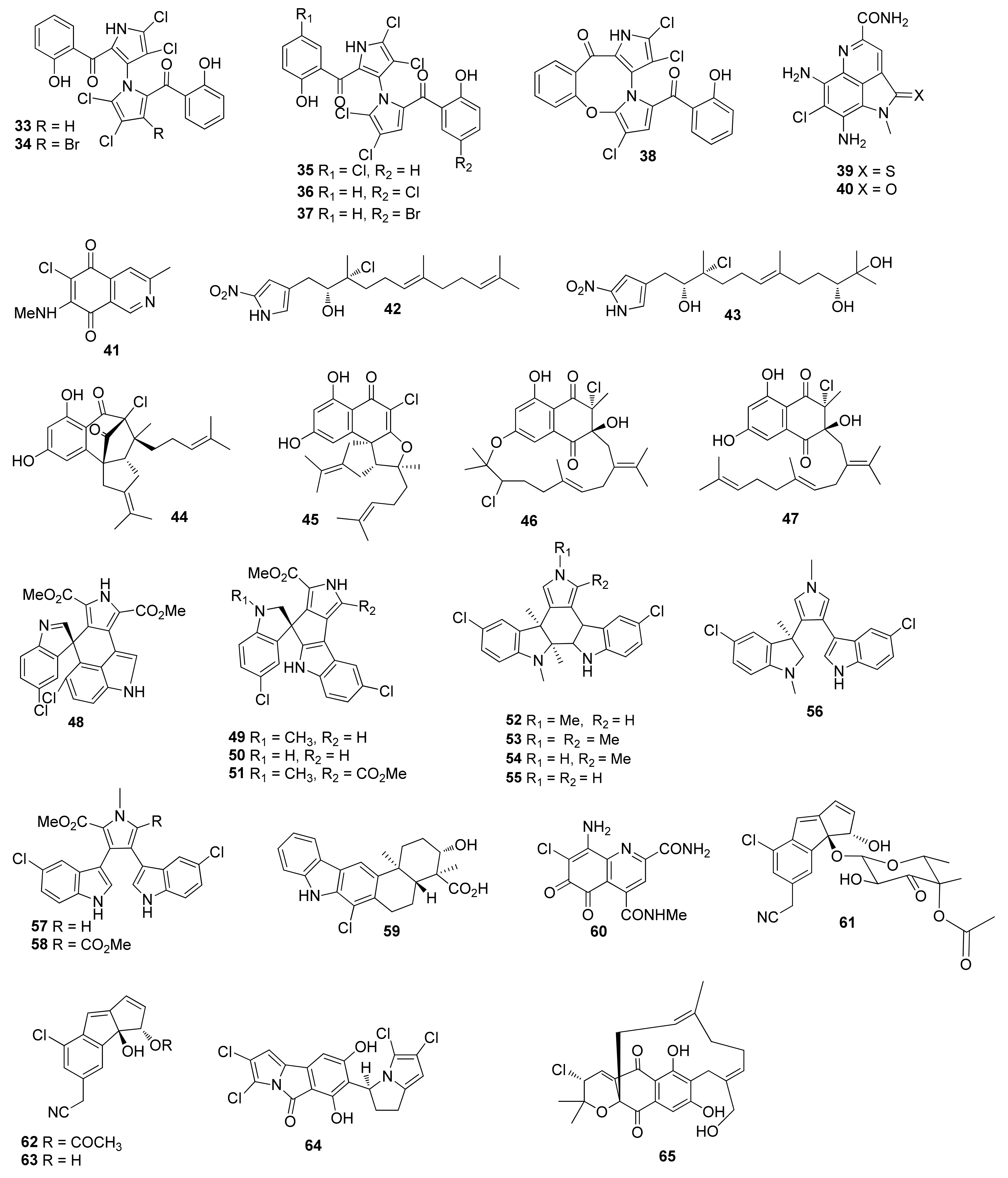


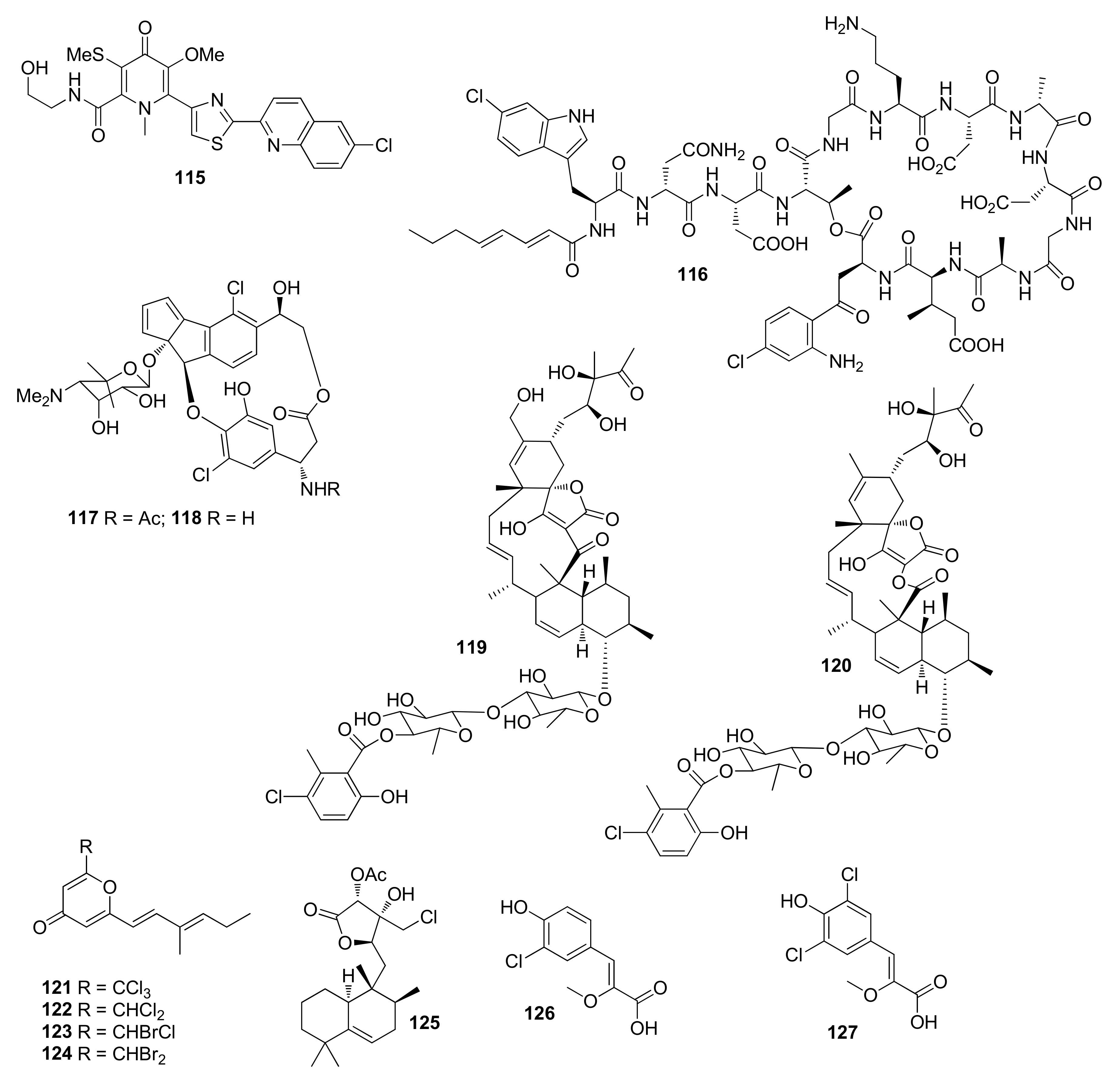
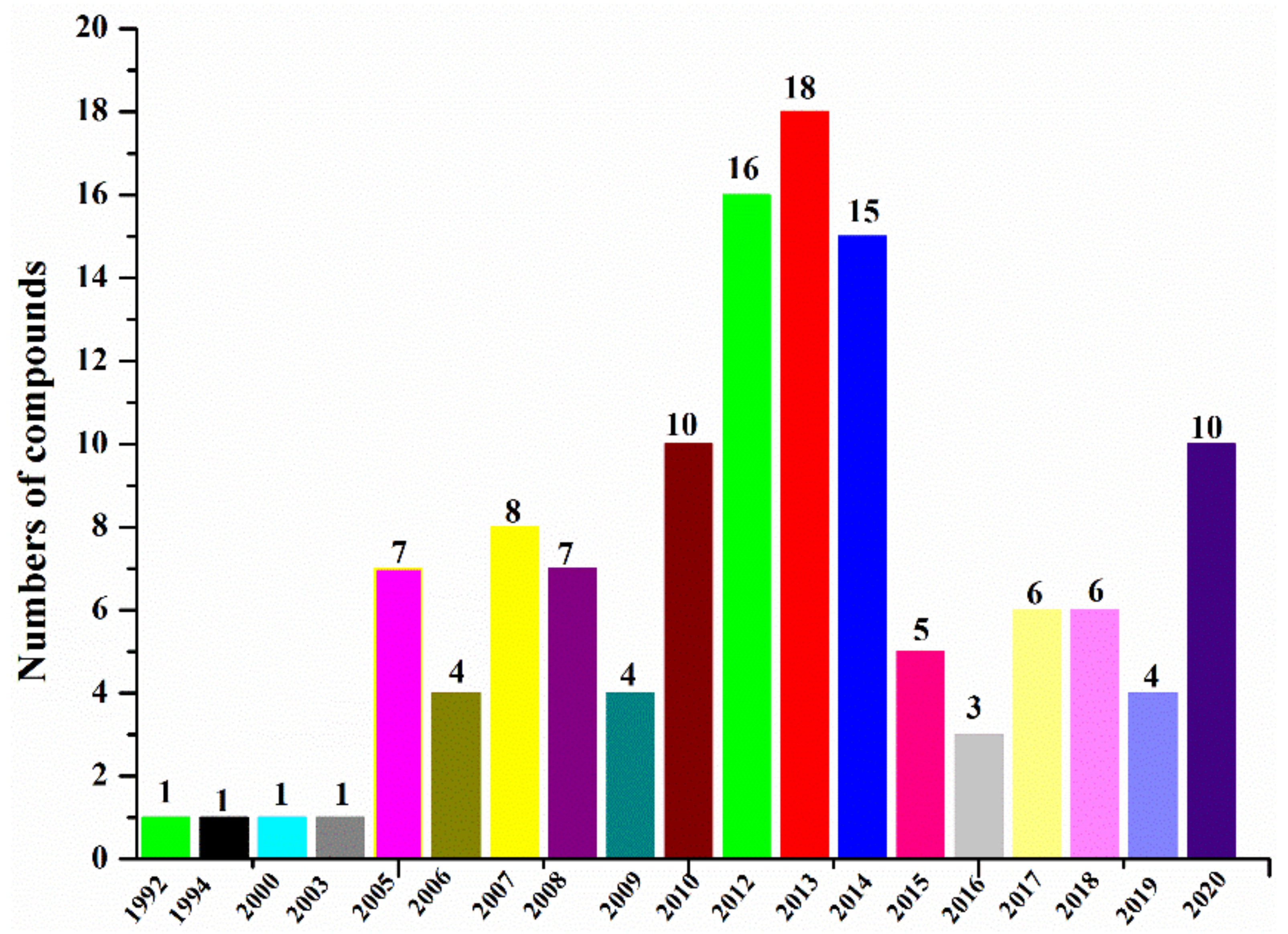

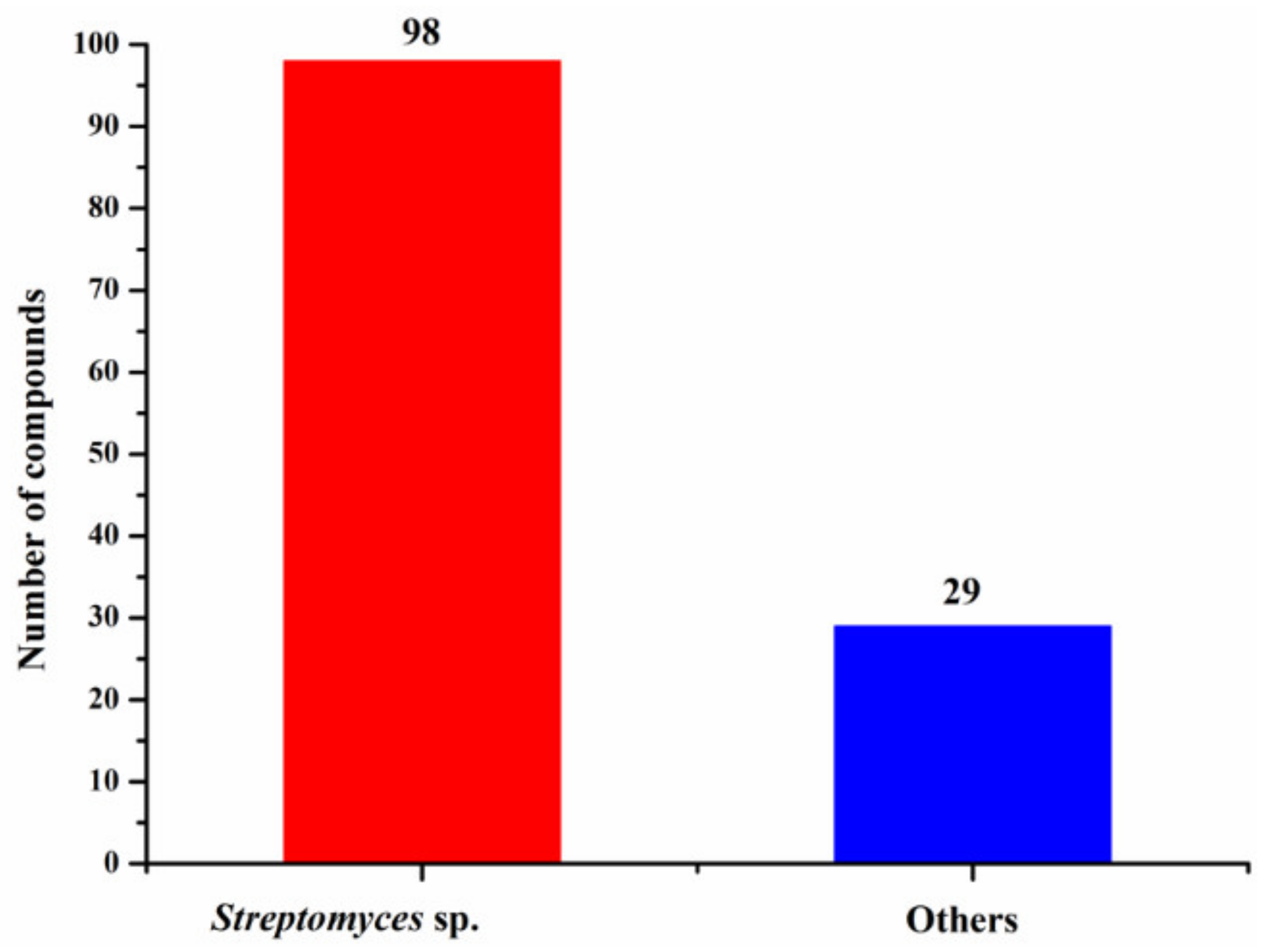
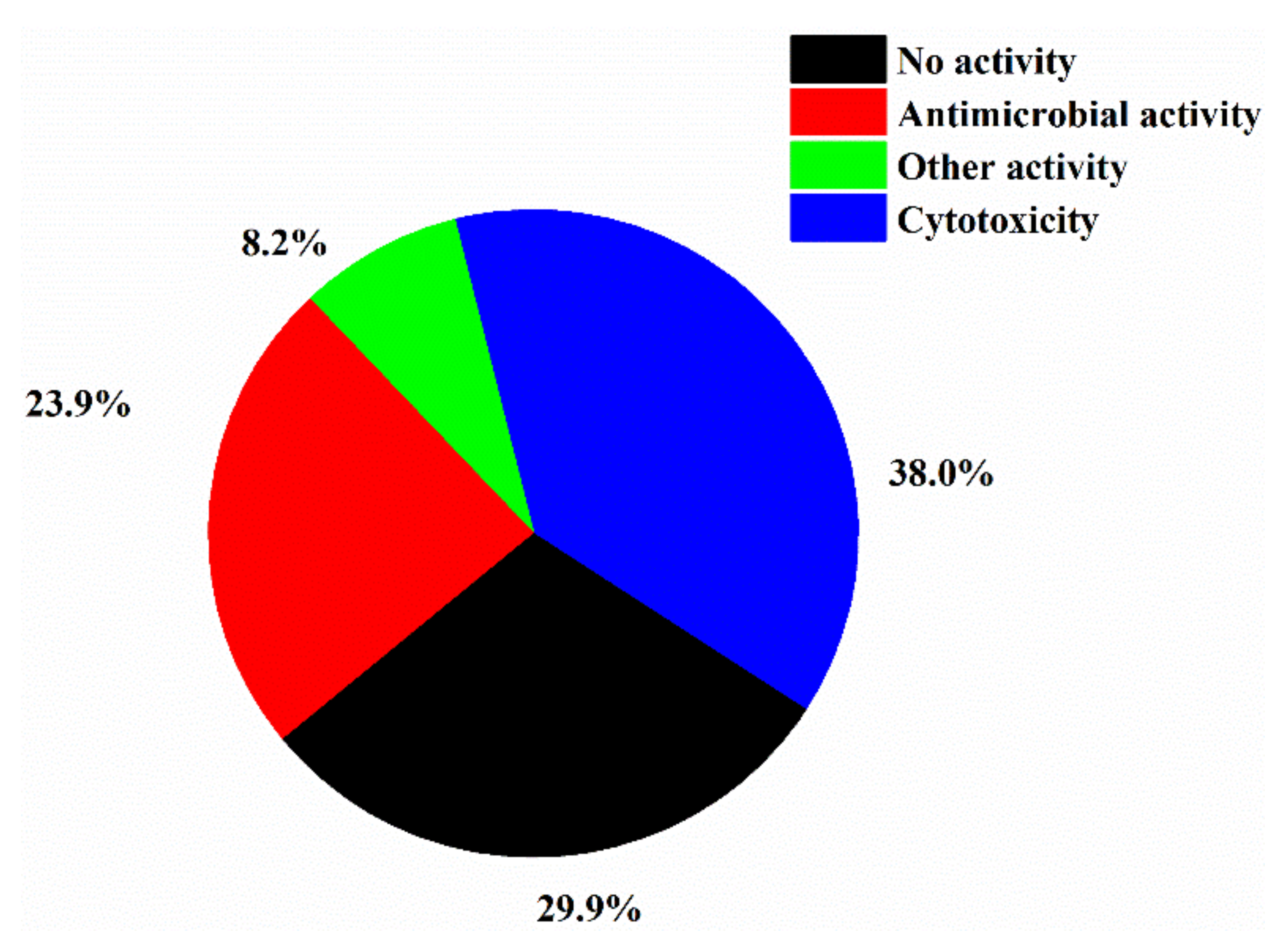
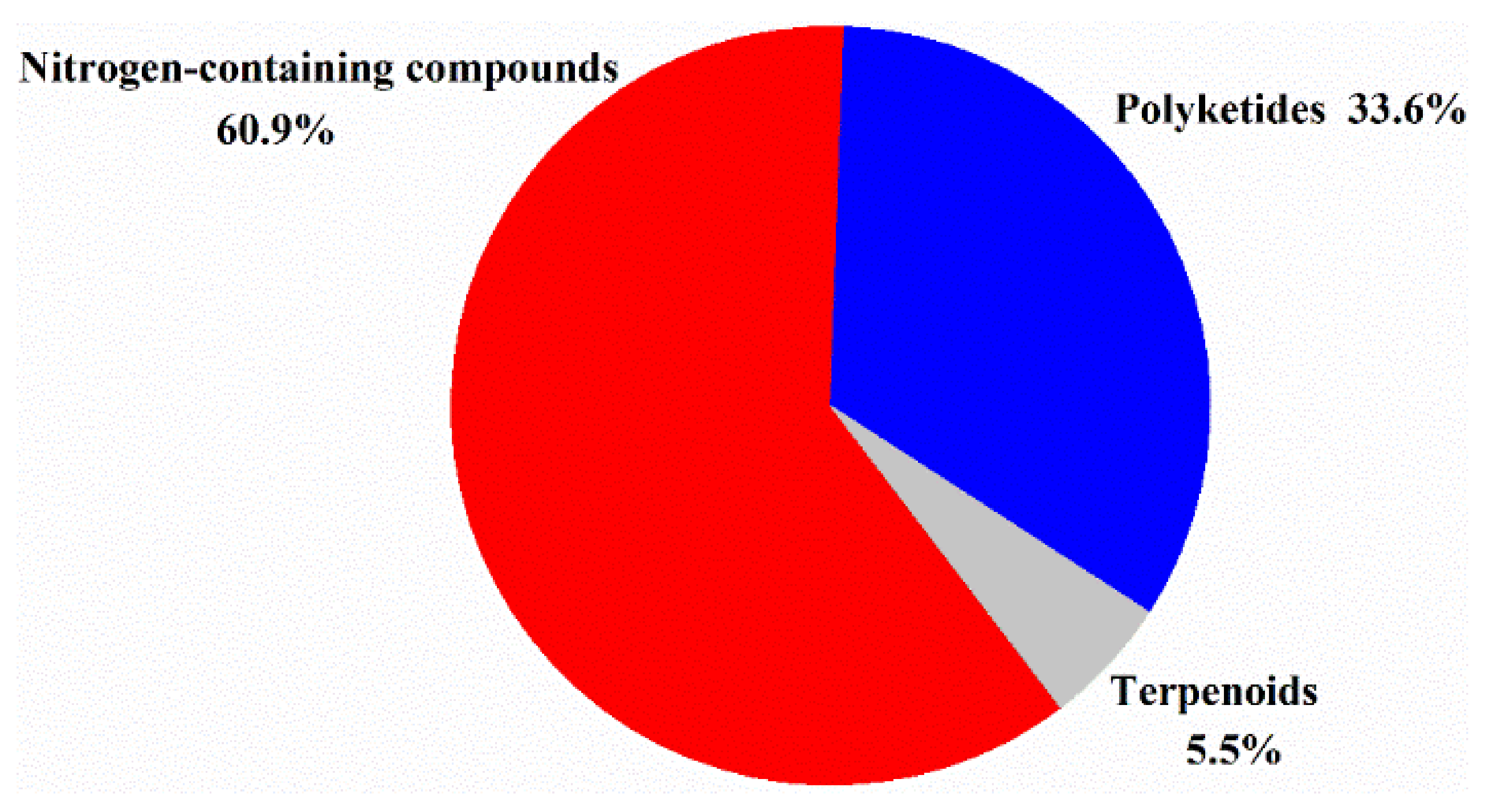
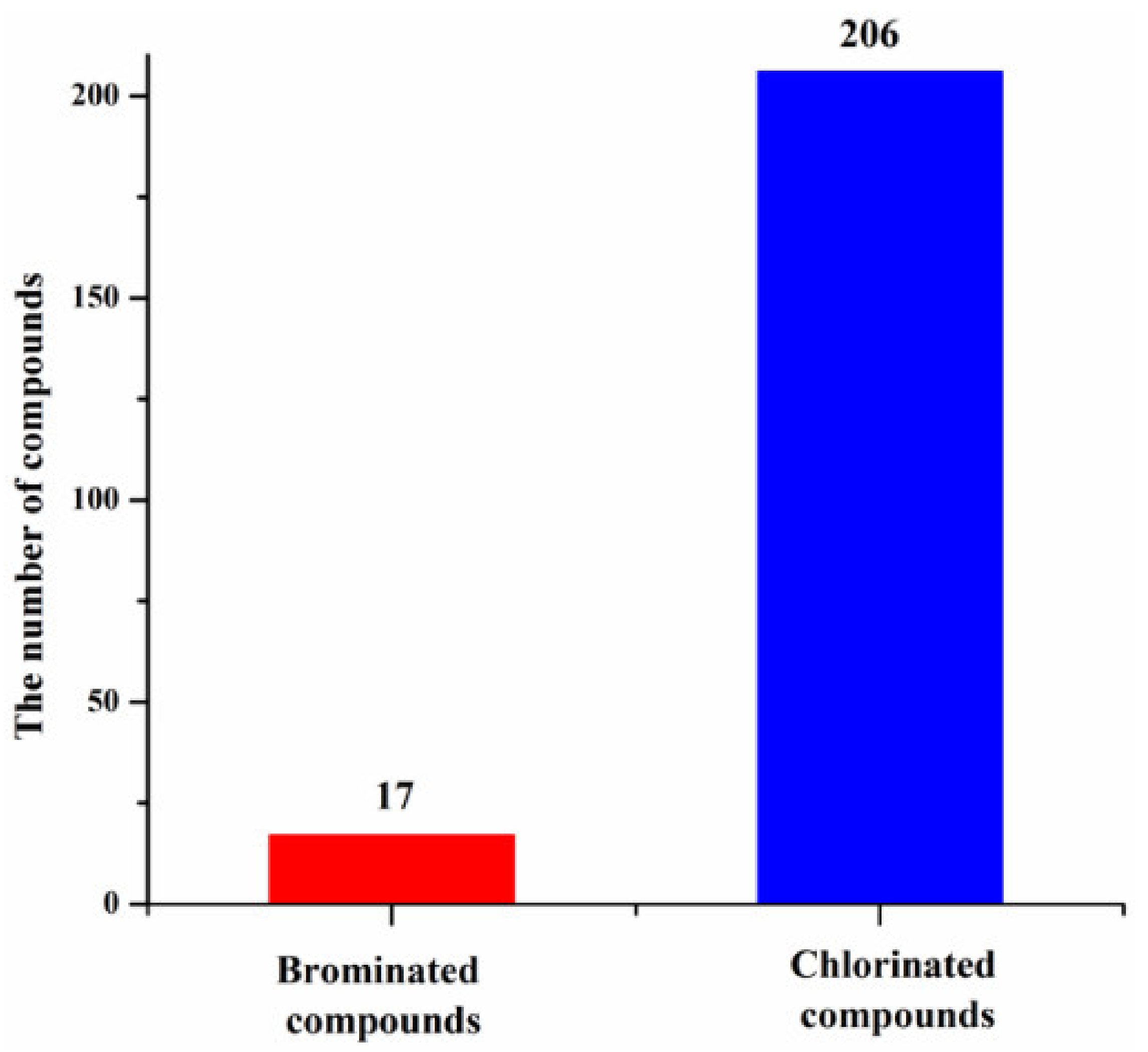
| First Producing Strain | Environment Source | Compound. | Time |
|---|---|---|---|
| Streptomyces sp. 1053U.I.1a.1b | Lienardia totopotens, Mactan Island, Cebu, Philippines | totopotensamides A (10) and B (11) | 1994 |
| Actinomycete CNB-632 (other marine actinomycetes) | Sediment sample, Tot-my Pines Estuary, La Jolla, CA | marinone (99) | 1992 |
| Compound | Producing Strain | Environment Source | Bioactivity | Ref. |
|---|---|---|---|---|
| 1–2 | Streptomyces sp. Sp080513GE-23 | Haliclona sp. Sponge, Chiba, Japan | / | [4,5] |
| 3 | Streptomyces sp. SBT345 | Agelas oroides sponge, Mediterranean Sea | Antioxidant and antichlamydial effects | [6,7] |
| 4–6 | Streptomyces coelicolor LY001 | sponge Callyspongia siphonella, the Saudi Red Sea | Antibacterial activity | [8] |
| 7–8 | Streptomyces sp. OUCMDZ-1703 | Unidentified soft coral, Weizhou Island, Guangxi, China | Cytotoxicity | [9] |
| 9 | Streptomyces hygroscopicus | Jellyfish Cassiopeia xamachana, Florida Keys | Antibacterial, Anti- inflammatory activity | [10] |
| 10–11 | Streptomyces sp. 1053U.I.1a.1b | Lienardia totopotens, Mactan Island, Cebu, Philippines | / | [11] |
| 12–15 | Streptomyces sp. Strain CA-271078 | Ascidian, the sea shore in Baía Ana Chaves, Sao Tome | 13–15: Cytotoxicity 13, 15: Antibacterial activity | [12,13] |
| 16–17 | Streptomyces sp. M045 | Sediment, Jiaozhou Bay, China | Cytotoxicity | [14] |
| 18 | Streptomyces sp. CNQ766 | Sediment, Island of Guam | / | [15,16] |
| 19 | Streptomyces sp. CNQ-583 | Sediment, Island of Guam | / | [17] |
| 20 | Streptomyces sp. CNH990 | Sediment, Cabo San Lucas, Mexico. | Cytotoxicity | [18] |
| 21 | Streptomyces sp. 04DH110 | Sediments, Ayajin Bay, East Sea of Korea | Cytotoxicity | [19,20] |
| 22–24 | Streptomyces sp. CNQ-593 | Sediment, Island of Guam | Cytotoxicity | [21,22] |
| 25–32 | Streptomcyces sp. CNQ525 | Sediment, La Jolla, CA | 26–27, 29–30, 32: Cytotoxicity 25–27: Antibacterial activity | [23,24,25] |
| 33–38 | Streptomyces sp CNQ-418 | Sediment, La Jolla, CA | Cytotoxicity | [26,27] |
| 39–40 | Streptomyces sp. CNR-698 | Sediment, Bahamas Islands | Cytotoxicity | [28,29] |
| 41 | Streptomyces sp. Mei37 | Sediment, Jade Bay, German | Cytotoxicity | [30,31] |
| 42–43 | S. malaysiensis CNQ-509 | Sediment, California | 42: Cytotoxicity | [32] |
| 44–47 | Streptomyces sp. CNH-189 | Sediment, Oceanside, California | / | [33] |
| 48–58 | Streptomyces sp. SCSIO 03032 | Sediment, Bay of Bengal | 49–51, 53: Cytotoxicity | [34,35,36,37] |
| 59 | Streptomyces sp. SCSIO 02999 | Sediment, South China Sea | Antibacterial activity | [38] |
| 60 | Streptomyces variabilis SNA-020 | Sediment, Bahamas | Cytotoxicity | [39] |
| 61–63 | Streptomyces sp. CNT-179 | Sediment, Bahamas | / | [40] |
| 64 | Streptomyces sp. CNH-287 | Sediment, San Diego, CA. | Cytotoxicity | [41,42] |
| 65–68 | Streptomyces sp. CNQ-329 | Sediment, San Diego, CA. | 65, 67–68: Cytotoxicity 65: Antibacterial | [43] |
| 69 | Streptomyces sp. CNH-070 | Sediment, Encinitas, California | Cytotoxicity | [43] |
| 70–72 | Streptomyces sp. SCSIO 10428 | Sediment, Beihai, Guangxi, China | Antibacterial activity | [44] |
| 73 | Streptomyces sp. ART5 | Sediment, East Siberian, Arctic Ocean | Cytotoxicity | [45] |
| 74–75 | Streptomyces sp. SNC-109-M3 | Sediment, Vava’u, Tonga | 74: Cytotoxicity | [46,47,48] |
| 76–77 | Streptomyces sp. SNM55 | Sediment, Buan, Korea | Antibacterial activity | [49] |
| 78–83 | Streptomycetaceae CNS-284 | Marine sediments, the Solomon Islands and in Palau | 78–79: TNF-α-induced NFκB activity and antibacterial activity; 80–83: Antibacterial activity and cytotoxicity | [50,51,52] |
| 84 | Streptomyces sp. HN-A101 | Mangrove soil, Hainan, China | / | [53] |
| 85–87 | Streptomyces sp. HNA39 | Marine sediment, Hainan, China | 86–87: Cytotoxicity | [54] |
| 88 | Streptomyces sp. G212 | Marine sediment, Quang Binh-Vietnam | Antifungl activity | [55] |
| 89–90 | Streptomyces sp. CNH-189 | Sediment, near Oceanside, California. | Antibacterial activity | [56] |
| 91–92 | Streptomyces sp. SCSIO 11791 | Sediment, South China Sea | cytotoxicity | [57] |
| 93–95 | Streptomyces olivaceus FXJ8.012Δ1741 | a gntR gene-disrupted deep-sea strain | / | [58] |
| 96–97 | Streptomyces pactum SCSIO 02999 | Sediment, South China Sea | / | [59,60] |
| 98 | Streptomyces sp. ZZ502 | Seaweed Ulva conglobatea (Family Ulvaceae). | / | [61] |
| 99 | Actinomycete CNB-632 | Sediment sample, Tot-my Pines Estuary, La Jolla, CA | Antibacterial activity | [62] |
| 100 | Actinomycete (strain # CNH-099) | Sediment, Batiquitos Lagoon, North of San Diego, CA | Cytotoxicity | [63] |
| 101–107 | Salinospora strain CNB-392(later assigned as Salinispora tropica) | Sediment, Chub Cay, Bahamas | 101, 106: Cytotoxicity 103: inhibitory activity against HIV-1 reverse transcriptase 106: chymotrypsin-like activity | [64,65,66,67,68,69] |
| 108–109 | Salinispora pacifica (designated CNS103) | Sediment, Palau | 108: Cytotoxicity | [70] |
| 110–114 | Marinispora sp. NPS12745 | Sediment, the coast of San Diego, California | Antibacterial activity | [71] |
| 115–116 | Saccharomonospora sp. CNQ490 | Marine sediment, the La Jolla Submarine Canyon | Cytotoxicity 116: Antibacterial activity | [72,73] |
| 117–118 | Nocardiopsis CNS-653 | Sediment sample, Fiji | TNF-R-induced NFκB | [74] |
| 119–120 | Micromonospora sp. CA-214671 | Marine sediments, the Canary Islands | Antibacterial activity | [75] |
| 121–124 | Actinomadura sp. WMMB499 | Ascidian Ecteinascidia turbinata | 123–124: Nrf2-ARE activity | [76] |
| 125 | Micromonospora sp. WMMC-218 | Ascidian Symplegma brakenhielmi, Florida, Stanblum State Park | Antibacterial activity | [77] |
| 126–127 | Saccharomonospora sp. KCTC-19160 | Korean Collection for Type Cultures | BACE1 activity | [78] |
Publisher’s Note: MDPI stays neutral with regard to jurisdictional claims in published maps and institutional affiliations. |
© 2021 by the authors. Licensee MDPI, Basel, Switzerland. This article is an open access article distributed under the terms and conditions of the Creative Commons Attribution (CC BY) license (https://creativecommons.org/licenses/by/4.0/).
Share and Cite
Wang, C.; Du, W.; Lu, H.; Lan, J.; Liang, K.; Cao, S. A Review: Halogenated Compounds from Marine Actinomycetes. Molecules 2021, 26, 2754. https://doi.org/10.3390/molecules26092754
Wang C, Du W, Lu H, Lan J, Liang K, Cao S. A Review: Halogenated Compounds from Marine Actinomycetes. Molecules. 2021; 26(9):2754. https://doi.org/10.3390/molecules26092754
Chicago/Turabian StyleWang, Cong, Weisheng Du, Huanyun Lu, Jianzhou Lan, Kailin Liang, and Shugeng Cao. 2021. "A Review: Halogenated Compounds from Marine Actinomycetes" Molecules 26, no. 9: 2754. https://doi.org/10.3390/molecules26092754
APA StyleWang, C., Du, W., Lu, H., Lan, J., Liang, K., & Cao, S. (2021). A Review: Halogenated Compounds from Marine Actinomycetes. Molecules, 26(9), 2754. https://doi.org/10.3390/molecules26092754







